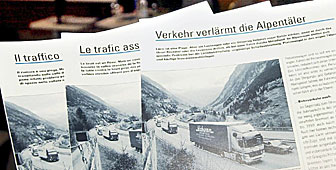Alpine Initiative still has mountain to climb

It's ten years since the Alpine Initiative - which aims to protect Switzerland's mountains from heavy goods vehicles - was enshrined in the constitution.
At the time it was hailed as a huge step forward in environmental protection but critics say not all of its objectives have been fully implemented.
The people and the cantons gave their backing to the initiative on February 20, 1994, after a long battle between the alpine lobby and government and the road lobby.
Since then it has been enshrined as article 84 in the Swiss constitution and offers two main ways to combat heavy road traffic – by moving freight from the roads on to rail and by stopping the building of new roads in mountain regions.
Toni Aschwanden from Alpine Initiative, the group which launched the original campaign, says that ten years on there is still a long way to go before all the initiative’s aims are fully achieved.
“The demand that transalpine freight be carried by rail is still not realised – the number of lorries crossing the Swiss Alps is still increasing, but without the measures implemented by the Alpine Initiative the situation would be even worse,” Aschwanden told swissinfo.
His view is borne out by recent figures published by the Federal Office for Spatial Development, showing that the number of heavy goods vehicles (HGVs) passing through the Gotthard, Great St Bernard and Simplon tunnels increased by three per cent last year.
Avanti counterproposal
Aschwanden adds that there have been a number of attempts to change alpine transit policy in the past ten years.
“The second part of the ten-year-old article is under constant attack by the road lobby, but luckily [their proposals] were all refused – the latest example being on February 8 when 62 per cent of voters and Swiss cantons rejected the counterproposal to the so-called Avanti initiative”.
In a national vote, the Swiss rejected a plan by the government and parliament – known as the Avanti counterproposal – to ease traffic congestion by spending up to SFr350 million annually to improve the country’s main roads and public transport.
The plan would have involved the construction of a second road tunnel through the Gotthard – Switzerland’s main north-south axis through the Alps.
Public and political will
Aschwanden says the failure of this proposal, and the success of others such as a tax on HGVs and the building of rail links through the Lötschberg and Gotthard tunnels, shows that the Swiss public still backs the environmentally friendly policy of moving freight from road to rail.
But he says that political will is needed to take things a step forward.
“The founders of the Alpine Initiative intended the text to be an objective, it’s up to the cabinet and the Swiss parliament to take measures to implement the text,” said Aschwanden.
Dumeni Columberg, a former Christian Democrat politician and president of the committee who opposed the Alpine Initiative, said he wasn’t surprised that the initiative hadn’t achieved all its aims.
“This initiative had some good notions, namely this idea to shift freight from road to rail but certain clauses were too extreme and weren’t realistic, such as transferring transit traffic on to rail in only ten years,” Columberg told swissinfo.
He said that in hindsight a better solution would have been to offer a counter initiative retaining core measures and leaving out what he considers the more extreme ones. He says that his committee underestimated public support for the initiative at the time.
More progress
But even Columberg is surprised that more progress has not been made in transferring freight to rail and agrees that more political pressure is needed.
“I am disappointed. These days the railway is probably able to put more freight on to rail but probably there is too little pressure to do this,” he said.
He added that other factors were the strong transport lobby and the fact that road transport is cheaper than rail, which makes competition between the two unequal.
Both Aschwanden and Columberg agree that the Alpine Initiative marked a sea change in Swiss transport policy, but Aschwanden is eager to see it taken further.
“We’re moving in the right direction now but we need to go further to make road transport policy less harmful to the environment,” he said.
swissinfo, Isobel Leybold
The people’s initiative “for the protection of the alpine regions from transit traffic” was handed in in 1990 with 107,570 signatures.
The Alpine Initiative calls for freight to be transferred from road to rail as well as a stop to new roads being built in the Alps.
The initiative was accepted by 51.9% of voters. It has subsequently been enshrined in the Swiss constitution.

In compliance with the JTI standards
More: SWI swissinfo.ch certified by the Journalism Trust Initiative













You can find an overview of ongoing debates with our journalists here . Please join us!
If you want to start a conversation about a topic raised in this article or want to report factual errors, email us at english@swissinfo.ch.